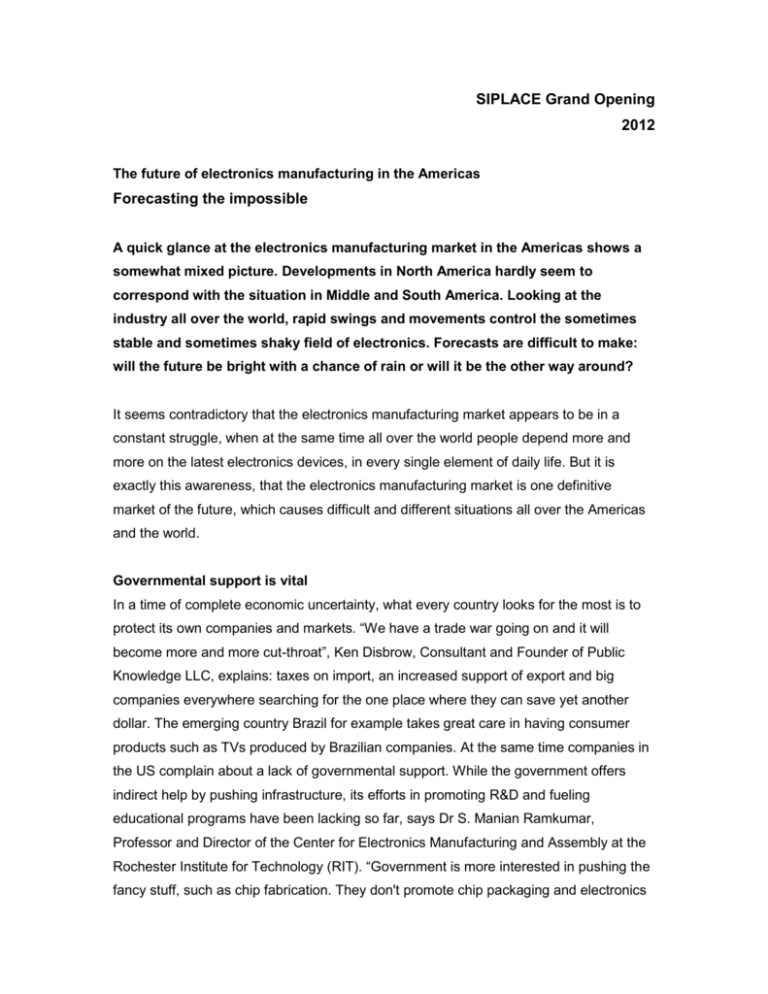Future of electronics manufacturing in the Americas
advertisement

SIPLACE Grand Opening 2012 The future of electronics manufacturing in the Americas Forecasting the impossible A quick glance at the electronics manufacturing market in the Americas shows a somewhat mixed picture. Developments in North America hardly seem to correspond with the situation in Middle and South America. Looking at the industry all over the world, rapid swings and movements control the sometimes stable and sometimes shaky field of electronics. Forecasts are difficult to make: will the future be bright with a chance of rain or will it be the other way around? It seems contradictory that the electronics manufacturing market appears to be in a constant struggle, when at the same time all over the world people depend more and more on the latest electronics devices, in every single element of daily life. But it is exactly this awareness, that the electronics manufacturing market is one definitive market of the future, which causes difficult and different situations all over the Americas and the world. Governmental support is vital In a time of complete economic uncertainty, what every country looks for the most is to protect its own companies and markets. “We have a trade war going on and it will become more and more cut-throat”, Ken Disbrow, Consultant and Founder of Public Knowledge LLC, explains: taxes on import, an increased support of export and big companies everywhere searching for the one place where they can save yet another dollar. The emerging country Brazil for example takes great care in having consumer products such as TVs produced by Brazilian companies. At the same time companies in the US complain about a lack of governmental support. While the government offers indirect help by pushing infrastructure, its efforts in promoting R&D and fueling educational programs have been lacking so far, says Dr S. Manian Ramkumar, Professor and Director of the Center for Electronics Manufacturing and Assembly at the Rochester Institute for Technology (RIT). “Government is more interested in pushing the fancy stuff, such as chip fabrication. They don't promote chip packaging and electronics assembly nearly enough, even though lately they have started shifting focus a little.” Varying regulations from state to state make operating from within the US even more difficult and so far, there is hardly any change in sight. Money to launch a well coordinated lobby and make the manufacturers’ struggles known is, sadly, still missing. Challenges in education Yet another problem within the US is the lack of skilled workers. Low public interest in electronics manufacturing does not bring in nearly enough university or college graduates to fill the empty positions at US-American companies. And while in Mexico and South America studying manufacturing is much more highly regarded and attractive, their schedules are not up-to-date and even conservative in most cases. “We are working towards creating more and more exchange programs,” Dr Ramkumar describes how the RIT tackles this unbalance. However once the students are trained and ready to start, it is hard to keep them in the US, despite them being able to choose from up to three or four job offers, due to visa and employment restrictions. Turnover of labor is soaring high: as soon as hardly skilled workers have undergone the necessary trainings, it seems they leave again. Fresh ideas and new angles However, it is not all either or, rain or sunshine: there appears to be more and more unexpected success stories which are born out of what at first looked like obvious downturns. For small contract manufacturers with big customers in medicine or defense, the future even seems bright. Electronics manufacturing is a worldwide business and the industry is making about 66 billion dollars a year. Only 3 billions of them are made in the US. So what does that mean? It is about keeping what the country already has. This requires, most of all, innovative thinking. Instead of offering just what a company has always offered to the customer, what is interesting to them now is added value: high quality, good service, presenting the whole package and collaborating. A few years ago, large OEM companies were focusing on slimming down and outsourcing. This lead to them losing touch with their contract manufacturers and their research – in the end it became a disadvantage. Today they are hiring again and communication is also improving. Another unexpected turn for the Americas market comes with rising costs of labor and living standards in Asia. Companies in the US, Canada, Mexico and Brazil who had moved their facilities to China are now realizing that the total cost of operations due to all the taxes, travel costs etc. has long risen to a level where on-shoring might be the new and brighter future. And the high mix low volume production that has become a specialty of the market is hard to transfer in any way. Then there is yet another factor of the future: sustainability is becoming more and more important. Keeping productions close to the customer is not only starting to become a cheaper option and a way to offer customers a hands-on feeling and better service, it is also much more eco-friendly. For North America this means that there is sun breaking through the clouds. For Middle and South America, business is getting brighter every day. For more information about ASMPT, please visit www.asmpacific.com Please direct any reader inquiries to: ASM Assembly Systems GmbH& Co. KG Susanne Oswald E-mail: susanne.oswald@asmpt.com Mark Ogden E-Mail: ogden.mark@asmpt.com






